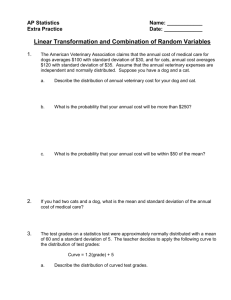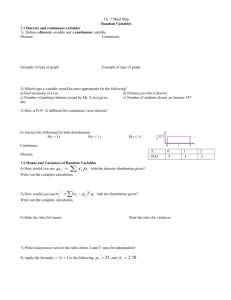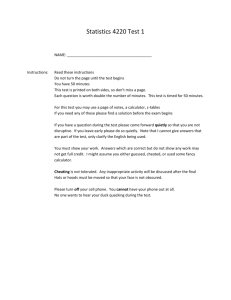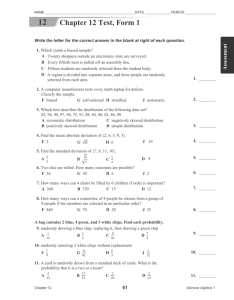Ch. 7 Free Response 14-A-3. Schools in a certain state receive
advertisement
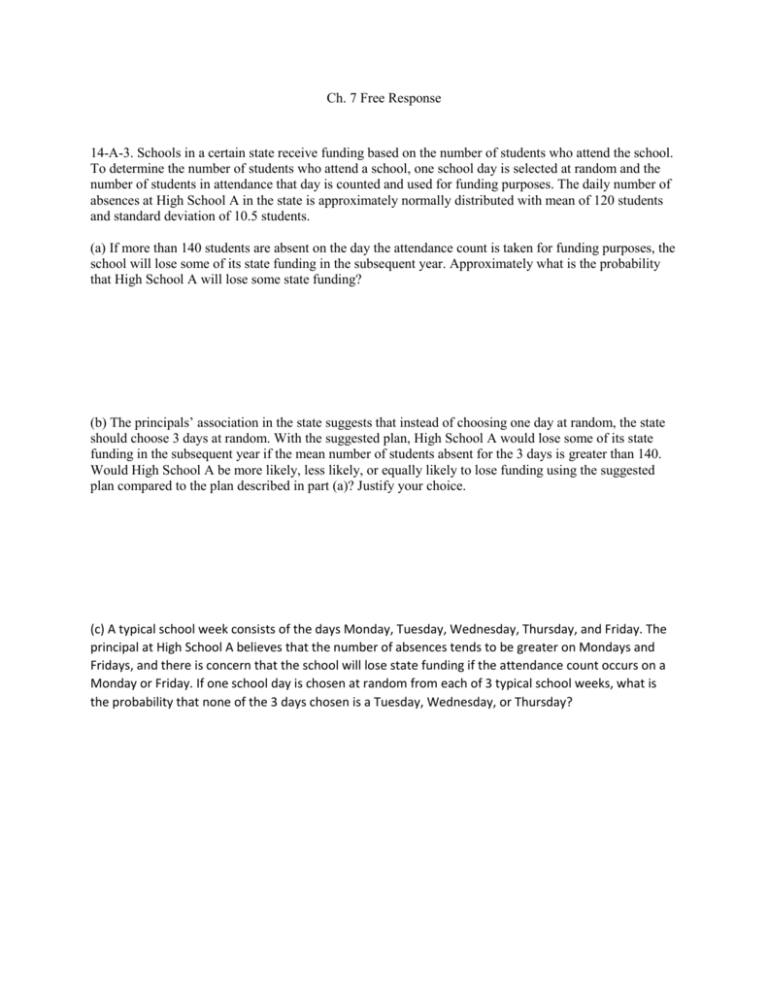
Ch. 7 Free Response 14-A-3. Schools in a certain state receive funding based on the number of students who attend the school. To determine the number of students who attend a school, one school day is selected at random and the number of students in attendance that day is counted and used for funding purposes. The daily number of absences at High School A in the state is approximately normally distributed with mean of 120 students and standard deviation of 10.5 students. (a) If more than 140 students are absent on the day the attendance count is taken for funding purposes, the school will lose some of its state funding in the subsequent year. Approximately what is the probability that High School A will lose some state funding? (b) The principals’ association in the state suggests that instead of choosing one day at random, the state should choose 3 days at random. With the suggested plan, High School A would lose some of its state funding in the subsequent year if the mean number of students absent for the 3 days is greater than 140. Would High School A be more likely, less likely, or equally likely to lose funding using the suggested plan compared to the plan described in part (a)? Justify your choice. (c) A typical school week consists of the days Monday, Tuesday, Wednesday, Thursday, and Friday. The principal at High School A believes that the number of absences tends to be greater on Mondays and Fridays, and there is concern that the school will lose state funding if the attendance count occurs on a Monday or Friday. If one school day is chosen at random from each of 3 typical school weeks, what is the probability that none of the 3 days chosen is a Tuesday, Wednesday, or Thursday? 13-A-3 Each full carton of Grade A eggs consists of 1 randomly selected empty cardboard container and 12 randomly selected eggs. The weights of such full cartons are approximately normally distributed with a mean of 840 grams and a standard deviation of 7.9 grams. (a) What is the probability that a randomly selected full carton of Grade A eggs will weigh more than 850 grams? (b) The weights of the empty cardboard containers have a mean of 20 grams and a standard deviation of 1.7 grams. It is reasonable to assume independence between the weights of the empty cardboard containers and the weights of the eggs. It is also reasonable to assume independence among the weights of the 12 eggs that are randomly selected for a full carton. Let the random variable X be the weight of a single randomly selected Grade A egg. i) What is the mean of X ? ii) What is the standard deviation of X ? 11.B.3. An airline claims that there is a 0.10 probability that a coach-class ticket holder who flies frequently will be upgraded to first class on any flight. This outcome is independent from flight to flight. Sam is a frequent flier who always purchases coach-class tickets. (a) What is the probability that Sam’s first upgrade will occur after the third flight? (b) What is the probability that Sam will be upgraded exactly 2 times in his next 20 flights? (c) Sam will take 104 flights next year. Would you be surprised if Sam receives more than 20 upgrades to first class during the year? Justify your answer. 10.A.4. An automobile company wants to learn about customer satisfaction among the owners of five specific car models. Large sales volumes have been recorded for three of the models, but the other two models were recently introduced so their sales volumes are smaller. The number of new cars sold in the last six months for each of the models is shown in the table below. Car Model Number of new cars sold in the last six months A 112,338 B 96,174 C 83,241 D 3,278 E 2,323 Total 297,354 The company can obtain a list of all individuals who purchased new cars in the last six months for each of the five models shown in the table. The company wants to sample 2,000 of these owners. (a) For simple random samples of 2,000 new car owners, what is the expected number of owners of model E and the standard deviation of the number of owners of model E? (b) When selecting a simple random sample of 2,000 new car owners, how likely is it that fewer than 12 owners of model E would be included in the sample? Justify your answer. (c) The company is concerned that a simple random sample of 2,000 owners would include fewer than 12 owners of model D or fewer than 12 owners of model E. Briefly describe a sampling method for randomly selecting. 10.B.3. A test consisting of 25 multiple-choice questions with 5 answer choices for each question is administered. For each question, there is only 1 correct answer. (a) Let X be the number of correct answers if a student guesses randomly from the 5 choices for each of the 25 questions. What is the probability distribution of X ? This test, like many multiple-choice tests, is scored using a penalty for guessing. The test score is determined by awarding 1 point for each question answered correctly, deducting 0.25 point for each question answered incorrectly, and ignoring any question that is omitted. That is, the test score is calculated using the following formula. Score = (1 x number of correct answers) – (0.25 x number of incorrect answers) + (0 x number of omits) For example, the score for a student who answers 17 questions correctly, answers 3 questions incorrectly, and omits 5 questions is Score = (1 x 17) - (0.25 x 3) + (0 x 5) = 16.25. (b) Suppose a student knows the correct answers for 18 questions, answers those 18 questions correctly, and chooses randomly from the 5 choices for each of the other 7 questions. Show that the expected value of the student’s score is 18 when using the scoring formula above. (c) A score of at least 20 is needed to pass the test. Suppose a student knows the correct answers for 18 questions, answers those 18 questions correctly, and chooses randomly from the 5 choices for each of the other 7 questions. What is the probability that the student will pass the test? 09.A.2. A tire manufacturer designed a new tread pattern for its all-weather tires. Repeated tests were conducted on cars of approximately the same weight traveling at 60 miles per hour. The tests showed that the new tread pattern enables the cars to stop completely in an average distance of 125 feet with a standard deviation of 6.5 feet and that the stopping distances are approximately normally distributed. (a) What is the 70th percentile of the distribution of stopping distances? (b) What is the probability that at least 2 cars out of 5 randomly selected cars in the study will stop in a distance that is greater than the distance calculated in part (a) ? (c) What is the probability that a randomly selected sample of 5 cars in the study will have a mean stopping distance of at least 130 feet?

